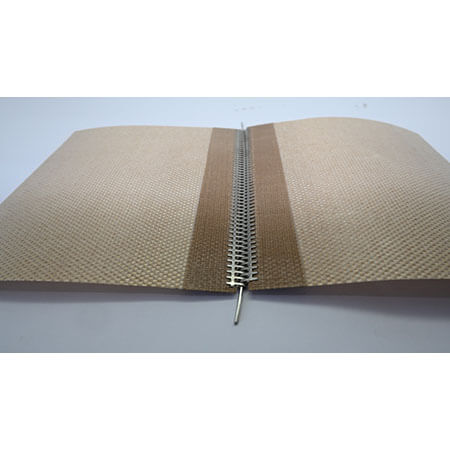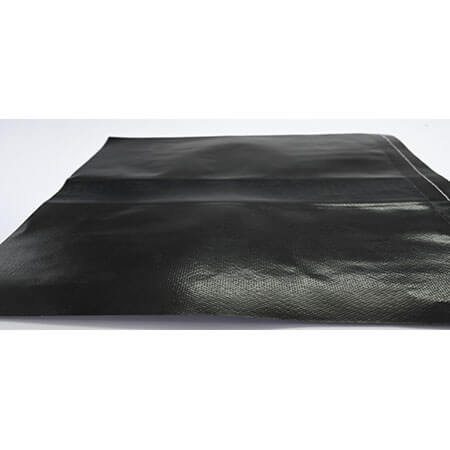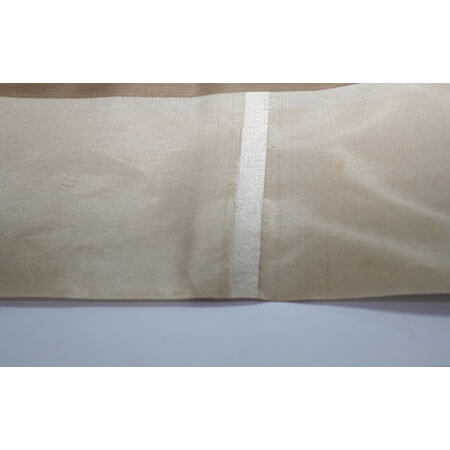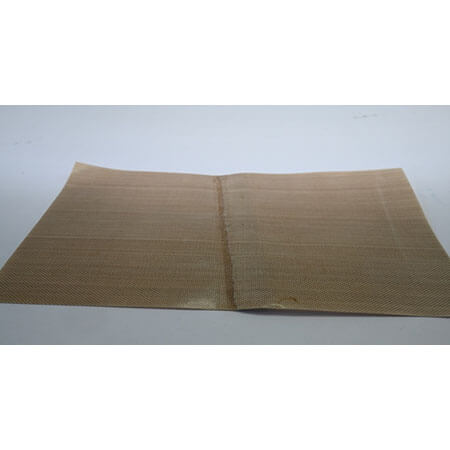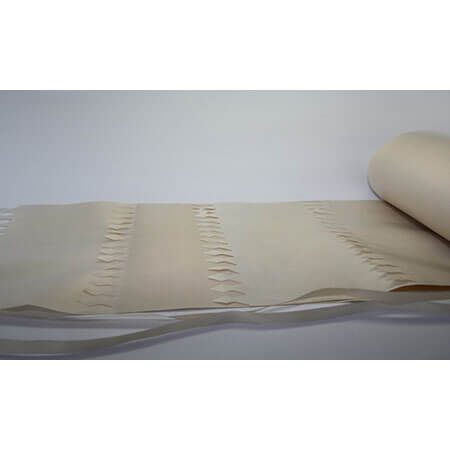Mechaical Fastener Conveyor Belt
As a premier manufacturer and supplier, our company is dedicated to providing high-quality conveyor solutions that meet the unique needs of various industries. Our designed to deliver durability, flexibility, and reliability to your production line. The Mechaical Fastener Conveyor Belt features a robust design equipped with durable fasteners that ensure a strong, dependable connection ideal for heavy-duty applications. These belts are specifically engineered to withstand the rigorous demands of industries such as mining, agriculture, and construction, where reliability is paramount.
Mechaical Fastener Conveyor Belt
Model - Mechanical Fasteners
Joining methods for Teflon Conveyor belts & power transmission belts
Mechanical fasteners join or fasten two objects together mechanically. They are used in places where conveyor belts must be changed regularly or for applications where the belt needs to be replaced quickly. However, the mechanical fastener is a vulnerable part of the belt and may have openings where dirt can enter, so this is not a preferred solution for many applications.
Mechanical fasteners join or fasten two objects together mechanically. They are used in places where conveyor belts must be changed regularly or for applications where the belt needs to be replaced quickly. However, the mechanical fastener is a vulnerable part of the belt and may have openings where dirt can enter, so this is not a preferred solution for many applications.
One of the key advantages of our
Our position as a global enables us to provide the products to clients around the world, backed by comprehensive support and service. From the initial consultation to after-sales care, our dedicated professionals offer guidance on belt selection, installation procedures, and ongoing maintenance. We ensure that you receive not only top-quality products but also continuous support to keep your operations running smoothly. Choose the reliable and efficient addition to your conveyor system. With our commitment to quality, innovation, and customer satisfaction, we provide a product that enhances both the productivity and the reliability of your operations. Trust our expertise to supply the best in conveyor belt technology, tailored to your industrial needs.
Mechaical Fastener Conveyor Belt
is its adaptability to various conveyor configurations and lengths. The mechanical fasteners allow for easy installation and maintenance, significantly reducing downtime and enhancing operational efficiency. This versatility makes our belts suitable for a wide range of applications, from small-scale packaging lines to large-scale material handling systems. Understanding that each facility has different requirements, we offer customizableMechaical Fastener Conveyor Belt
. Our team works closely with clients to tailor belts according to specific widths, lengths, and fastener types, ensuring the perfect fit for your existing systems. Whether you need enhanced load capacity or specialized belt materials, we are equipped to meet your specifications.Our position as a global enables us to provide the products to clients around the world, backed by comprehensive support and service. From the initial consultation to after-sales care, our dedicated professionals offer guidance on belt selection, installation procedures, and ongoing maintenance. We ensure that you receive not only top-quality products but also continuous support to keep your operations running smoothly. Choose the reliable and efficient addition to your conveyor system. With our commitment to quality, innovation, and customer satisfaction, we provide a product that enhances both the productivity and the reliability of your operations. Trust our expertise to supply the best in conveyor belt technology, tailored to your industrial needs.
Enquiry Now
Products List
Joining methods for Teflon Conveyor belts & power transmission belts
The fabric ends are cut in a finger pattern, matched together, then hot pressed. With this kind of joint, the weld length is decisive for the tensile strength. The joint part is quite flat, and it has a good result in the transporting article that require a flat joint. Application industries including apparel fusion machines, food conveyors (ex. egg crust, Mexican crust pre-cooking automation equipment), electronic parts, etc.
Joining methods for Teflon Conveyor belts & power transmission belts
The ends of the fabric are skived to a wedge shape, one end of the belt from the top, the other from the underside, and bonded together using PFA film, heat and pressure. This is a very strong welding method, and offer a very smooth transition for the product to run on the machine.
Joining methods for Teflon Conveyor belts & power transmission belts
Butt joint is made by placing the two ends of a belt together and applying a certain wide piece of material underneath. This is then welded together ensuring the top surface is neat. Butt Belt Joints tend to be manufactured prior to fitting on the machine and are manufactured using a strap on the underside to offer additional strength. This method is a simple but very effective on making a belt endless at customer’s site. In the meantime, it can be an idea for machine isn’t easy to unassembled for belt replacement.
Joining methods for Teflon Conveyor belts & power transmission belts
With pre-inserted staples and a one-piece strip design, which Hinged and Stapled Fasteners makes splicing quick and easy (allows for quicker installation and easy change). The joint portion is flexible and it is made with special plastic material which allows you to use it in a certain high temperature environment, please contact us for more details.
Joining methods for Teflon Conveyor belts & power transmission belts
A castellated joint is made by creating interlocking loops from PTFE coated Kevlar materials. The two ends can then be connected together with a metal or peek pin. This method is easy to install on the machine while it has a feature of more flat than spiral peek joint method.
Joining methods for Teflon Conveyor belts & power transmission belts
Overlap Belt Joints – Overlap joints are a simple and easy joint to use where having an even surface is not critical. Overlap splices are the most popular type used in the industry and can be enhanced with molding for food processing applications. Overlap ranges from 25 mm to 140mm, with directional belt angles of 30, 45, 60, and 90 degrees. This type of joint can easy be made on a machine where the belt needs to be fitted onsite.
Joining methods for Teflon Conveyor belts & power transmission belts
We recommend the overlapped finger joint. As in this case, the ends to be joined are split into layers. Next, fingers are punched into the ends, which are then tacked together and welded under pressure and heat into an endless belt.
Again, the double-layer fabric is applied from the beginning to the end, using high temperature and pressure, so the tensile strength of the belt will be improved and it is especially suitable for conveyors with small wheel diameters, such as continuous sealing machinery and toilet paper packaging machinery.
Edging reinforcement and Tracking types
GCTC provide most of kinds of processing solutions to strengthen the edge of the conveyor belt, mainly to provide the anti-resistance feature and service life time of the belt. The most common way is to use a Teflon film to cover the edge for 1- inch width, and then place under the laminating machine with high temperature and pressure to cover the edge perfectly. Alternative way is using a piece of glass Fiber fabrics sewing onto the edges. To prevent direction shift t you can choose Kevlar or silicone rope to form the guide rope and sew it at a distance of 1/2" from the edge. This is a customized option. The following pictures and abbreviations are available for your reference.
Edge reinforcement - Teflon Glass Fabric Edging
Tracking Kevlar Rope
Silicone Tracking Rope
Tracking Eyelet
 English
English Français
Français Deutsch
Deutsch Русский
Русский Português
Português Italiano
Italiano हिन्दी
हिन्दी Español
Español Nederlandse
Nederlandse العربية
العربية Tiếng Việt
Tiếng Việt ภาษาไทย
ภาษาไทย Bahasa Indonesia
Bahasa Indonesia বাঙ্গালী
বাঙ্গালী Türk
Türk 繁體中文
繁體中文